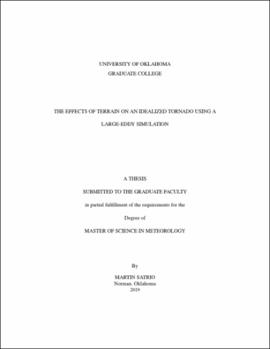| dc.description.abstract | Tornado structure is known to be sensitive to the characteristics of near-surface inflow, which in turn is affected by inhomogeneities in surface features. Many observational studies such as VORTEX-SE have identified potential influences of terrain on tornado dynamics, particularly in areas of complex terrain such as the southeast United States. However, investigating terrain effects observationally poses a number of challenges, including temporal and spatial limitations. While past studies have resorted to damage analysis and numerical simulations to examine such effects, a comprehensive sensitivity study on the effects of various types of terrain on tornadoes has yet to be done. Examining the behavior of tornadoes that traverse terrain features may aid in understanding patterns of tornado strengthening / weakening and give insight on damage patterns left behind from complex near-surface flow structure in areas of complex surface terrain. In the present study, a large-eddy simulation (LES) model is utilized to simulate a tornado-like vortex moving at a fixed translational velocity over varying surface terrain. An immersed boundary method modifies the Navier-Stokes equations at the terrain feature such that all components of the ground-relative components of the flow are forced to zero. Different simulations are grouped into one of four categories depending on terrain type - 3D hills, 2D sinusoidal hills, valleys, and ridges - and within each of these categories slight modifications to the characteristics of the terrain or the vortex are implemented to examine the vortex's response to certain changes.
The study finds that as the vortex traverses the different terrain features, the vortex becomes unsteady and asymmetric, especially at levels nearest to the surface where friction plays the largest role. For 2D sinusoidal and 3D hill simulations, enhanced 10-m horizontal wind speeds occur in two distinct areas: 1) in between adjacent hills as a result of flow channeling and 2) on the upslope portion of the hill which is a product of short-lived but robust secondary vortices. The secondary vortices are hypothesized to form as a result of stretching of pre-existing vertical vorticity, associated with terrain-induced enhanced convergence. Analysis of the pressure field at 10 m show that the addition of terrain into the LES model does produce predictable path deviations that repeat with respect to the terrain, with a southern (northern) preference on the downslope (upslope) side of the hill. Additionally, composite analyses reveal that the near-surface core radius is widest (most narrow) as the vortex ascends (descends) the terrain. The valley simulations have the largest horizontal wind speed and the ridge simulations have the highest vertical wind speeds overall. For hill and sinusoid cases, the region between adjacent hills have the fastest horizontal winds and the uphill side has the largest vertical winds. Statistical calculations also show overall horizontal and vertical wind speeds as well as turbulent kinetic energy values are a function of the overall characteristics of surface terrain such as the slope and size. | en_US |
